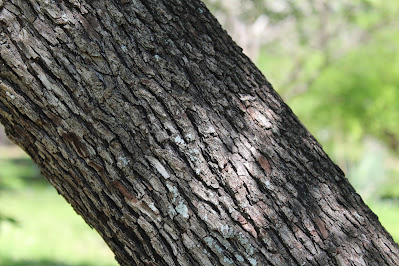 |
Our tree of the week is a hawthorn, the Pensacola hawthorn (Crataegus lacrimata). The Centenary College arboretum might be the only place in Shreveport where you can study a Pensacola, or weeping, hawthorn. This species is not native to Louisiana; it has a small native range around the Florida panhandle.
|
 |
Our tree of the week grows at the southern edge of the arboretum. In the immediate foreground, we see the intersection of two sidewalks, which currently serve as a border for the arboretum proper. Past the sidewalk, on the left we see a mockernut hickory (Carya tomentosa), and on the right we see a young yaupon holly (Ilex vomitoria). The Pensacola hawthorn is pictured further back, in the center of the frame. On the far right, we see a blog favorite, the flowering magnolia (Magnolia grandiflora). Although not clearly visible in this photograph, it should be mentioned that our Pensacola hawthorn grows near a beautiful hawthorn (Crataegus pulcherrima) and a Washington hawthorn (Crataegus phaenopyrum). Here you have the opportunity to compare three distinct species of hawthorn; go check them out in person to see if you can identify any noteworthy distinctions.
|
 |
To help the Pensacola hawthorn standout in the landscape, a pink tape was tied around the thickest trunk, at which point, the trunk has a circumference of 25 inches. In this photograph, we can see the characteristic 'weeping' branches.
|
 |
Our Pensacola hawthorn has taken on a multi-stem habit, making it a shrub rather than a tree. Although it seems to be the case that there was initially one trunk that started to lean too much, at which point, additional stems were cultivated for balance. And perhaps it is the case that the longevity of this 'tree' depends on the removal of the older, thicker trunk.
|
 |
The dark gray bark on the trunk is very rough.
|
 |
While standing under the tree and looking up, we see dense coverage and an irregular mess of thorny, uninviting branches. This isn't a bad shade tree as long as you can prune the lower branches to keep the thorns away from the faces of those passersby.
|
 |
On this one small twig, we see 10 leaves and a flower cluster. Three flowers have already dropped their petals; one flower is open; and one flower bud has not yet opened. Unfortunately, looking closely at the flower bud, it appears that we might still have rust on this grouping of hawthorns. We have been battling the cedar-apple rust and/or cedar-quince rust for years now. Three eastern red cedars have been removed from the arboretum in the hopes of saving the hawthorns. You can read more about the struggle on previous blog posts (here and here). But, this year, the beautiful and Pensacola hawthorns look great, significantly better than the last two years.
|
 |
The leaf base is cuneate and the tip is pointed. Edges are serrated.
|
 |
This leaf tip is obtuse, and here we see the new leaf accompanied by a new thorn. Yay....
|
 |
This week there are still plenty of flowers on the Pensacola hawthorn.
|
 |
While not actually seeing them, some people might find the large number of pretty white flowers disagreeable. Simply walking on the nearby sidewalk is enough to experience the undesirable odor.
|
 |
| Pensacola hawthorn flowers, photographed March 26, 2023 |
 |
While most of us would prefer to keep our distance from the pretty little flowers, plenty of flying insects were buzzing around the tree.
|
You can find older photos of this individual on a previous blog post, here. That post is from 2012, more than a decade ago.












